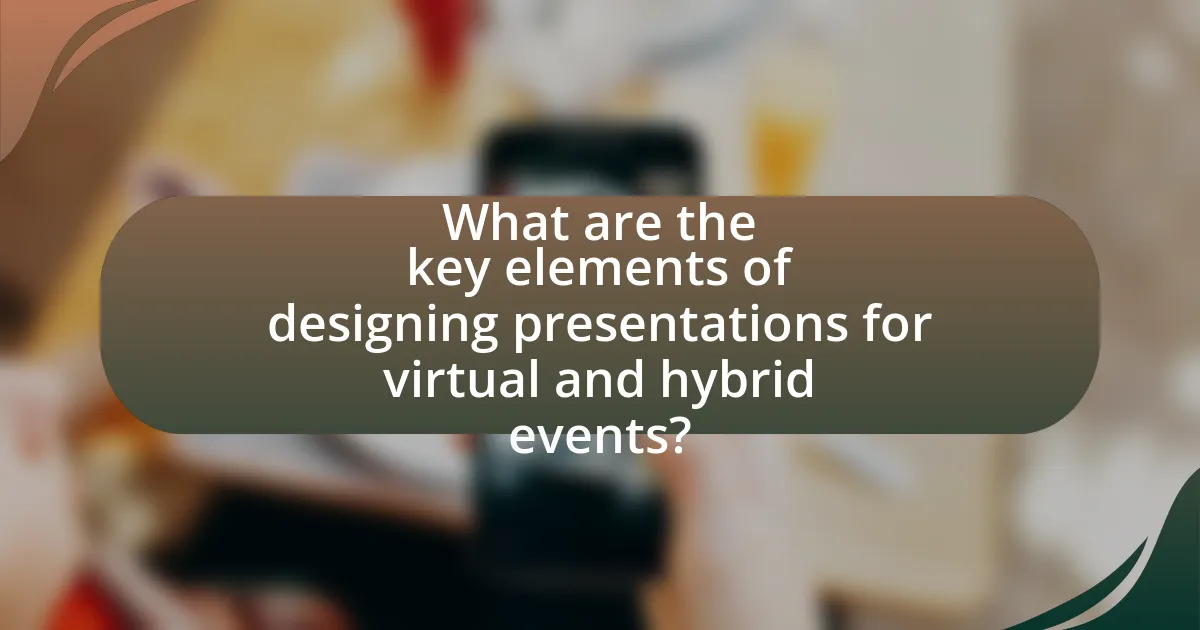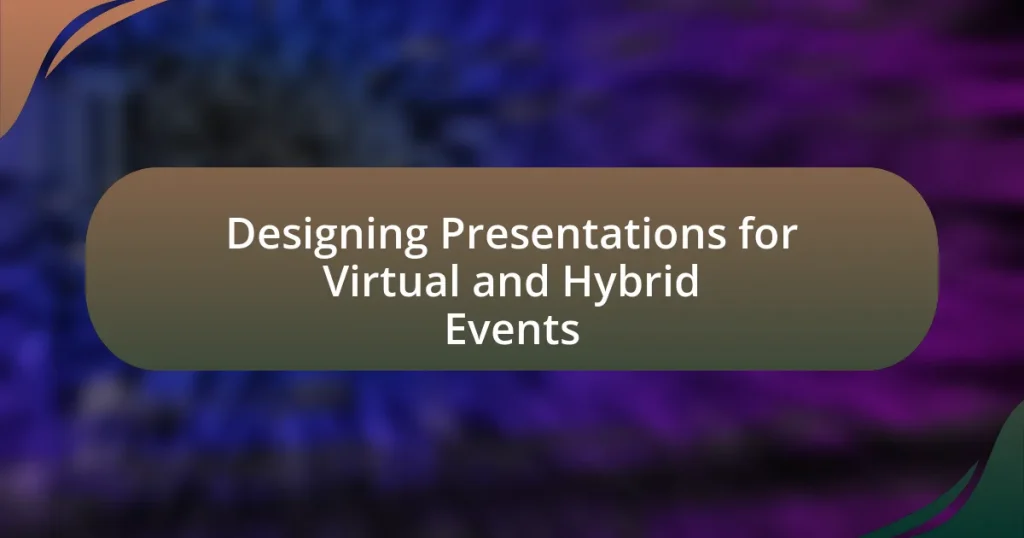The article focuses on designing presentations for virtual and hybrid events, emphasizing key elements such as engaging content, interactive features, and effective technology integration. It explores how audience engagement strategies differ between virtual and hybrid formats, highlighting the importance of interactive tools like live polling and Q&A sessions. Additionally, the article addresses technological considerations, audio-visual quality, and design principles essential for successful presentations. It also discusses common challenges faced in these formats and best practices for enhancing audience participation and feedback collection, ultimately providing actionable insights for improving future presentations.

What are the key elements of designing presentations for virtual and hybrid events?
The key elements of designing presentations for virtual and hybrid events include engaging content, interactive features, and effective technology integration. Engaging content captures the audience’s attention and maintains interest, often utilizing storytelling techniques and relevant visuals. Interactive features, such as polls, Q&A sessions, and breakout rooms, enhance audience participation and foster a sense of community. Effective technology integration ensures seamless delivery, utilizing reliable platforms that support high-quality audio and video, as well as user-friendly interfaces. Research indicates that presentations incorporating these elements can significantly improve audience retention and satisfaction, as evidenced by a study from the Virtual Event Institute, which found that 70% of attendees prefer interactive sessions over traditional presentations.
How do audience engagement strategies differ in virtual and hybrid formats?
Audience engagement strategies differ in virtual and hybrid formats primarily in their approach to interaction and participation. In virtual formats, engagement often relies on digital tools such as polls, chat functions, and breakout rooms to facilitate real-time interaction among participants who are not physically present. For instance, platforms like Zoom and Microsoft Teams enable features that allow instant feedback and questions, fostering a sense of community despite physical separation.
In contrast, hybrid formats combine both in-person and virtual elements, requiring strategies that cater to both audiences simultaneously. This includes using technology to ensure that remote participants can engage with in-person attendees, such as live streaming sessions and interactive Q&A segments that involve both groups. According to a report by Eventbrite, 70% of event organizers noted that hybrid events require more planning to ensure equitable engagement for both audiences, highlighting the complexity of managing interactions across different formats.
Thus, while virtual engagement focuses on maximizing online tools for interaction, hybrid engagement necessitates a dual approach that integrates both physical and digital experiences to create a cohesive event atmosphere.
What interactive tools can enhance audience participation in virtual events?
Interactive tools that can enhance audience participation in virtual events include live polling platforms, Q&A features, and breakout rooms. Live polling platforms, such as Slido or Mentimeter, allow participants to engage in real-time feedback, making them feel involved in the event. Q&A features enable attendees to ask questions and receive answers during the presentation, fostering interaction and clarity. Breakout rooms facilitate smaller group discussions, encouraging networking and deeper engagement among participants. These tools have been shown to increase audience engagement significantly, with studies indicating that events utilizing interactive elements can see participation rates rise by over 30%.
How can presenters maintain attention in a hybrid setting?
Presenters can maintain attention in a hybrid setting by actively engaging both in-person and virtual audiences through interactive elements. Utilizing tools such as polls, Q&A sessions, and breakout discussions encourages participation from all attendees, fostering a sense of inclusion. Research indicates that interactive presentations can increase audience retention by up to 70%, as they promote active involvement rather than passive listening. Additionally, presenters should frequently check in with both audiences, ensuring that virtual participants feel acknowledged and valued, which further enhances engagement and attention.
What technological considerations are essential for successful presentations?
Successful presentations require reliable technology, including high-quality audio-visual equipment, stable internet connectivity, and user-friendly presentation software. High-quality audio-visual equipment ensures clear visuals and sound, which are critical for audience engagement; for instance, studies show that 65% of people are visual learners, making effective visuals essential. Stable internet connectivity prevents disruptions during virtual presentations, as a survey by Zoom indicated that 70% of users experienced improved engagement with stable connections. User-friendly presentation software, such as PowerPoint or Google Slides, allows presenters to create and share content seamlessly, enhancing the overall experience for both the presenter and the audience.
Which platforms are best suited for virtual and hybrid presentations?
The best platforms for virtual and hybrid presentations include Zoom, Microsoft Teams, and Webex. These platforms offer robust features such as high-quality video conferencing, screen sharing, and interactive tools like polls and Q&A sessions, which enhance audience engagement. For instance, Zoom supports up to 1,000 video participants and provides breakout rooms for smaller discussions, making it ideal for large events. Microsoft Teams integrates seamlessly with Office 365, allowing for easy collaboration and document sharing during presentations. Webex is known for its security features and scalability, accommodating various audience sizes effectively. These platforms are widely adopted in corporate and educational settings, demonstrating their reliability and effectiveness for virtual and hybrid formats.
How do audio-visual quality and setup impact the presentation experience?
Audio-visual quality and setup significantly enhance the presentation experience by ensuring clear communication and engagement. High-quality audio prevents misunderstandings and distractions, while clear visuals maintain audience attention and comprehension. Research indicates that 65% of people are visual learners, meaning effective visuals can improve retention and understanding of the presented material. Additionally, a well-organized setup, including appropriate lighting and equipment positioning, fosters a professional atmosphere, which can increase audience trust and interest. Thus, the combination of superior audio-visual quality and thoughtful setup directly correlates with a more effective and impactful presentation experience.
What design principles should be followed for effective presentations?
Effective presentations should adhere to principles such as clarity, consistency, engagement, and visual hierarchy. Clarity ensures that the message is easily understood, which can be achieved by using simple language and avoiding jargon. Consistency in design elements, such as fonts, colors, and layout, helps the audience follow along without confusion. Engagement can be fostered through interactive elements, such as polls or Q&A sessions, which maintain audience interest. Visual hierarchy guides the viewer’s attention to the most important information first, utilizing size, color, and placement strategically. Research indicates that presentations incorporating these principles are more likely to retain audience attention and convey messages effectively, as supported by studies on cognitive load theory and visual communication.
How can visual aids be optimized for virtual and hybrid audiences?
Visual aids can be optimized for virtual and hybrid audiences by ensuring clarity, accessibility, and engagement. Clear visuals, such as high-contrast colors and large fonts, enhance readability on various screens, while accessible formats, like captions and alternative text, cater to diverse audience needs. Engaging elements, such as interactive polls or embedded videos, can maintain audience interest and participation. Research indicates that presentations incorporating these strategies can improve audience retention by up to 70%, demonstrating their effectiveness in enhancing communication in virtual and hybrid settings.
What role does branding play in presentation design for these events?
Branding plays a critical role in presentation design for virtual and hybrid events by ensuring consistency and recognition across all visual elements. Effective branding enhances audience engagement and retention by creating a cohesive experience that aligns with the event’s identity. For instance, studies show that consistent branding can increase audience recall by up to 80%, emphasizing the importance of visual identity in presentations. This includes the use of logos, color schemes, and typography that reflect the brand’s values and messaging, ultimately fostering a stronger connection with the audience.
How can presenters adapt their content for different formats?
Presenters can adapt their content for different formats by tailoring their messaging, visuals, and engagement strategies to suit the specific medium. For instance, in virtual formats, presenters should utilize interactive elements like polls and Q&A sessions to maintain audience engagement, while in hybrid events, they must ensure that both in-person and remote participants can interact seamlessly. Research indicates that effective adaptation can enhance audience retention by up to 60%, demonstrating the importance of format-specific strategies in communication.
What are the common challenges faced in virtual and hybrid presentations?
Common challenges faced in virtual and hybrid presentations include technical issues, audience engagement, and effective communication. Technical issues often arise from poor internet connectivity, software glitches, or inadequate equipment, which can disrupt the flow of the presentation. Audience engagement is challenging because virtual settings can lead to distractions, making it difficult for presenters to maintain attention and interaction. Effective communication is hindered by the lack of non-verbal cues, which are crucial for conveying messages and gauging audience reactions. These challenges are supported by studies indicating that 70% of presenters experience technical difficulties during online events, and research shows that audience retention drops significantly in virtual formats compared to in-person presentations.
What best practices should be followed for engaging virtual and hybrid audiences?
To effectively engage virtual and hybrid audiences, presenters should prioritize interactivity and inclusivity. Engaging audiences can be achieved through the use of polls, Q&A sessions, and breakout discussions, which encourage participation and maintain attention. Research indicates that interactive elements can increase audience retention by up to 70%, as highlighted in a study by the University of California, which found that active participation significantly enhances learning outcomes. Additionally, ensuring that both in-person and virtual participants feel included by addressing them equally and using technology that allows seamless interaction is crucial for maintaining engagement across diverse formats.
How can feedback be effectively gathered during and after presentations?
Feedback can be effectively gathered during and after presentations by utilizing interactive tools and structured surveys. During the presentation, real-time polling applications like Slido or Mentimeter can engage the audience and collect immediate responses, allowing presenters to adjust their content based on audience reactions. After the presentation, distributing a structured survey via platforms such as Google Forms or SurveyMonkey can capture detailed feedback on various aspects, including content clarity, engagement level, and overall satisfaction. Research indicates that 70% of participants prefer providing feedback through digital surveys, highlighting their effectiveness in gathering comprehensive insights.
What are the key takeaways for improving future presentations?
Key takeaways for improving future presentations include focusing on audience engagement, utilizing clear visuals, and practicing effective delivery techniques. Engaging the audience can be achieved through interactive elements such as polls or Q&A sessions, which have been shown to increase retention and participation. Clear visuals, including infographics and concise slides, enhance understanding and keep the audience’s attention, as studies indicate that visuals can improve information retention by up to 65%. Effective delivery techniques, such as varying tone and pacing, help maintain interest and convey enthusiasm, which is crucial in virtual and hybrid formats where distractions are prevalent.
